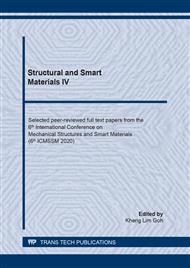[1]
Inasaki, I., (1991). Monitoring and Optimization of Internal Grinding Process. CIRP Ann. Manuf. Technol., 40, p.359–362.
DOI: 10.1016/s0007-8506(07)62006-x
Google Scholar
[2]
Daneshi, Amir, Nima Jandaghi, and Taghi Tawakoli, (2014). Effect of dressing on internal cylindrical grinding. Procedia CIRP 14, pp.37-41.
DOI: 10.1016/j.procir.2014.03.064
Google Scholar
[3]
Xiao, G., & Malkin, S. (1996). On-line optimization for internal plunge grinding. CIRP annals, 45(1), 287-292.
DOI: 10.1016/s0007-8506(07)63065-0
Google Scholar
[4]
Gupta, R.; Shishodia, K.S.; Sekhon, G.S., (2001). Optimization of grinding process parameters using enumeration method. J. Mater. Process. Technol. 112, p.63–67.
DOI: 10.1016/s0924-0136(01)00546-5
Google Scholar
[5]
Chatterjee, S.; Rudrapati, R.; Kumar pal, P.; Nandi, G., (2018). Experiments, analysis and parametric optimization of cylindrical traverse cut grinding of aluminium bronze. Mater. Today: Proc. 5, p.5272–5280.
DOI: 10.1016/j.matpr.2017.12.110
Google Scholar
[6]
Li, G.F.; Wang, L.S.; Yang, L.B., (2002) Multi-parameter optimization and control of the cylindrical grinding process. J. Mater. Process. Technol. 129, p.232–236.
DOI: 10.1016/s0924-0136(02)00607-6
Google Scholar
[7]
Rana, P.; Lalwani, D.I., (2017). Parameters optimization of surface grinding process using Modified"constrained Differential Evolution. Mater. Today: Proc. 4, p.10104–10108.
DOI: 10.1016/j.matpr.2017.06.329
Google Scholar
[8]
Warnecke, G.; Barth, C., (1999). Optimization of the Dynamic Behavior of Grinding Wheels for Grinding of Hard and Brittle Materials Using the Finite Element Method. CIRP Ann. Manuf. Technol. 48, p.261–264.
DOI: 10.1016/s0007-8506(07)63179-5
Google Scholar
[9]
Vu Ngoc Pi, Luu Anh Tung, Le Xuan Hung and Banh Tien Long, (2016). Cost Optimization of Surface Grinding Process, Journal of Environmental Science and Engineering A5, pp.606-611.
DOI: 10.17265/2162-5298/2016.12a.002
Google Scholar
[10]
Tran, T. H., Hoang, X. T., Le, H. K., Nguyen, Q. T., Nguyen, T. T., Nguyen, T. T. N., Jun, G., & Vu, N. P. (2020). A Study on Cost Optimization of External Cylindrical Grinding. Materials Science Forum, 977, p.18–26.
DOI: 10.4028/www.scientific.net/msf.977.18
Google Scholar
[11]
Tran, T.-H., et al., (2019). Optimization of replaced grinding wheel diameter for minimum grinding cost in internal grinding. Applied Sciences, 9(7), p.1363.
DOI: 10.3390/app9071363
Google Scholar
[12]
Tu, H.X., et al., (2018). Determining optimum parameters of cutting fluid in external grinding of 9CrSi steel using Taguchi technique. SSRG Int. J. Mech. Eng, 5(6): pp.1-5.
DOI: 10.14445/23488360/ijme-v5i6p101
Google Scholar


